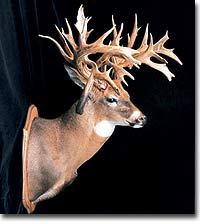
He might have been the highest-scoring non-typical of all time. But even if he wasn't, he still was among the most intriguing.
By Gordon Whittington
There's a common belief that top-end whitetails can only be grown in intensively farmed areas. Perhaps this view is understandable, for many of history's greatest deer have come from fertile agricultural zones. But no matter how sterile the big woods might seem, truly wild backcountry also can produce super racks.
The stunning 39-pointer shown here is a classic case in point. He lived in remote northern Minnesota, a vast block of forest far different from the state's heavily farmed southern tier. But the lack of crops apparently didn't do much to hurt his antler growth!
We'd be happy to tell you exactly what this stunning rack scores, but we can't. Nor can anyone else. This is actually a set of the deer's shed antlers picked up late in the winter of 1989-90. The inside spread, a vital component of any official Boone and Crockett score, thus can only be estimated. But given what appears to be a rather conservative inside spread of 23 3/8 inches, these sheds would have a huge net score of 334 0/8 points.
Serious trophy deer hunters understand the magnitude of that number, because the overall world record (held by a buck found dead near St. Louis, Missouri, in 1981) scores 333 7/8. The "Minnesota Monarch" well could have been the highest-scoring buck of all time!
Although this big-woods behemoth apparently was never shot by a hunter, he was well known for a good part of his lifetime. This familiarity is due to the fact he frequented a winter feeding area literally in the yard of a local resident. The individual, who wishes to remain anonymous, had been feeding deer around his rural home for many years before the giant first showed up back in the 1980s.
According to the homeowner's detailed journals, the buck could be depended on to arrive in mid-February. He always came into the feeding area alone, and he never appeared to interact at all with any of the does or other bucks there. Once the brunt of winter had passed, the mighty buck and the rest of the herd would disperse back into the remote backwoods from which they'd come.
Fortunately, for three successive years (in early 1989, 1990 and 1991) the non-typical shed his rack before disappearing again. This has given us a rare glimpse into the growth of a world-class whitetail.
When the deer first began showing up, his rack was far smaller than it eventually became. In fact, of his three known sets of sheds, the 1990 rack shown here was by far the largest. The 19-point rack found in 1989 would have had a net score in the 230s on the B&C system; the 30-point set found in 1991 would have scored a tad over 200 with spread included.
What might have caused such a tremendous difference in antler score that middle year? There's been speculation that it happened, because going into the winter of 1988-89, the man changed his feed formulation somewhat. Perhaps that helped the buck get off to a better start on the incredible rack he grew during 1989.
Although the man never revealed his exact feed formulation for that or any other year, he did say that everything in the various mixtures was readily available at feed stores. But perhaps exactly what was in the feed really didn't matter. Given that the other bucks in the area apparently didn't grow far larger-than-normal racks in 1989, and the non-typical dropped off so much the following year, it's tough to support any claim that the change in feed was a major factor in increasing the non-typical's rack size from one year to the next.
Many factors influence antler size and shape, among them age, genetics and overall health. This buck is believed to have been in his eighth or ninth year of life when he showed up in 1990, so perhaps he simply topped out that year and began to decline as a natural consequence of advanced age.
The giant never again showed up at the man's home after leaving in early 1991, and as far as anyone knows, he wasn't tagged by a hunter. Nor, it seems, were any later sheds found by other parties. As a result, we can only wonder what became of this mammoth whitetail. Was he dragged down by one of the area's packs of timber wolves? Did he drown after falling through thin ice on a wilderness lake? Might old age finally have caught up with him? Was he shot by a backwoods hunter but then never found?
With each passing year, it becomes less likely that we'll ever know. All anyone can say with certainty is that the 1989 rack of the "Minnesota Monarch" is the greatest set of whitetail sheds ever recorded, as signified by its No. 1 ranking in the North American Shed Hunters Club record book.
At 180 gross inches, the right antler is by far the largest single shed in existence, and the 139 4/8-inch left antler from that year also ranks among the top handful ever found. When you pair up these two huge antlers you get a gross non-typical score of 319 4/8 and a net of 310 5/8 - and remember, that's with no spread credit included.
Not bad for a buck that had to make his living way back in the wilderness. Just think how big he might have been had he spent his entire life down on the farm!




